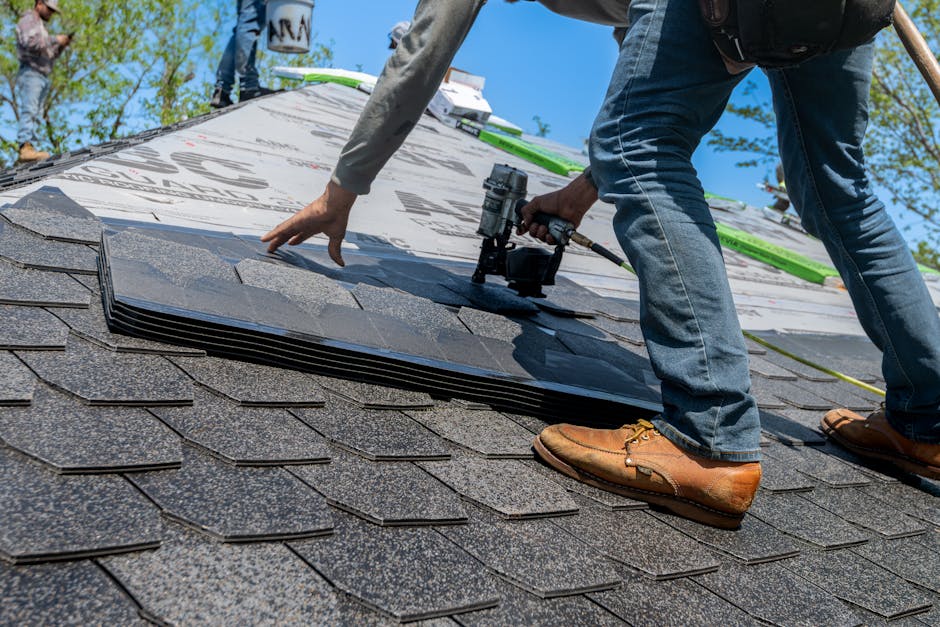Why Asphalt Shingle Roofing Dominates American Homes
Asphalt shingle roofing is the most popular residential roofing material in North America, and for good reason. It offers an unbeatable combination of affordability, durability, and style that makes it the go-to choice for millions. For homeowners seeking dependable roofing services, understanding this material is the first step toward a successful project.
Key Facts About Asphalt Shingle Roofing:
- Economical: Materials often cost $0.80-$1.20 per square foot.
- Durable: Lifespans range from 15 to over 50 years depending on the type.
- Versatile: Available in three main types (3-tab, dimensional, luxury) and hundreds of styles.
- Easy to Install: The simplest roofing material to install, saving on labor costs.
- Well-Warrantied: Comes with strong manufacturer guarantees.
Nearly 70% of residential roofs feature asphalt shingles because they deliver reliable weather protection without breaking the bank. Whether you’re recovering from storm damage or planning a new construction, choosing the right asphalt shingle is crucial for your home and budget.
As Andre Castro, CEO of Sienna Roofing & Solar, I’ve seen how the right shingle transforms a home’s protection and curb appeal. This guide will walk you through everything you need to know to make an informed decision for your Houston-area home.
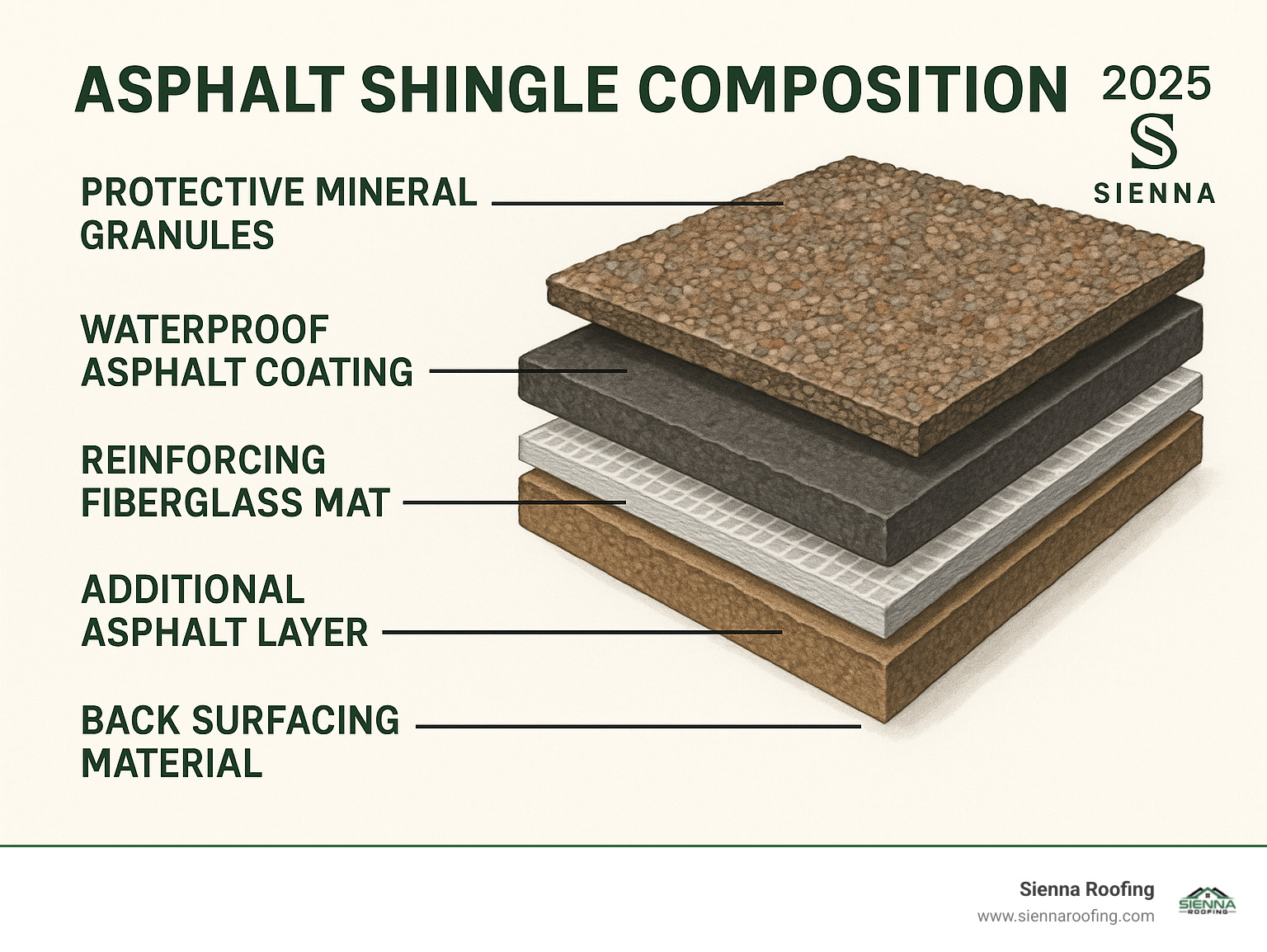
Understanding Asphalt Shingles: Composition, Types, and Styles
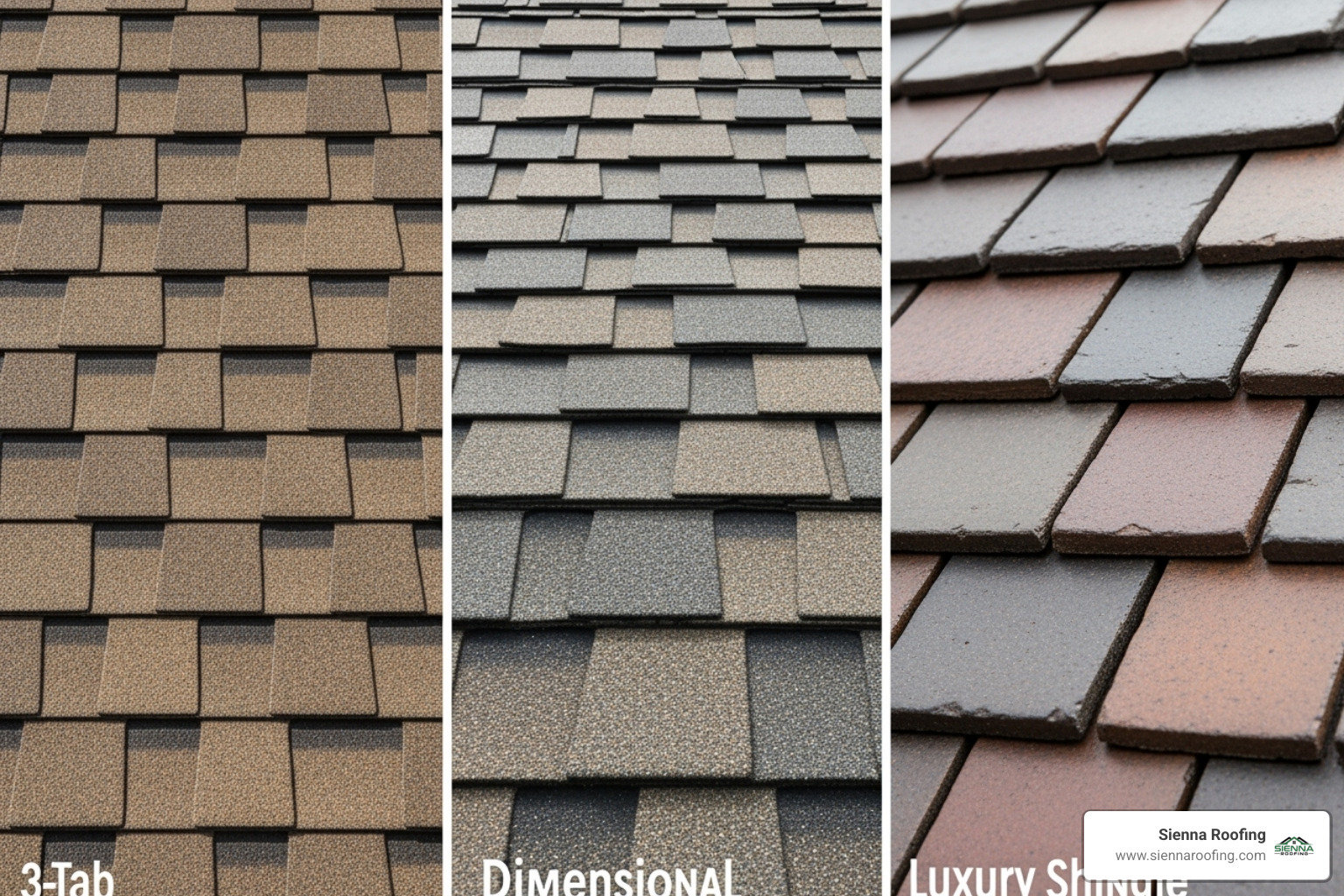
Today’s asphalt shingle roofing is a sophisticated composite designed for performance and style. Modern shingles start with a strong but lightweight fiberglass mat as their backbone. This mat is saturated with waterproof asphalt, the key ingredient for weatherproofing your home. The top surface is embedded with mineral granules, which provide color and protect the shingle from UV rays. Some granules even fight algae or reflect solar heat. A final back surfacing prevents shingles from sticking together in the package, ensuring a smooth installation.
All quality asphalt shingles must meet strict industry standards overseen by organizations like the Asphalt Roofing Manufacturers Association (ARMA), ensuring you get a product that performs as promised.
The Three Main Types of Asphalt Shingles
Choosing the right shingle is about balancing appearance, budget, and performance. Asphalt shingle roofing offers three distinct categories to meet different needs.
- 3-Tab Shingles: The most traditional and budget-friendly option. These single-layer shingles create a clean, uniform look and typically last 15-20 years.
- Dimensional (Architectural) Shingles: The modern standard. These multi-layered shingles add texture and shadow lines that mimic natural materials like wood shakes. Their thickness provides better durability and a lifespan of 22-25 years.
- Luxury Shingles: The top-of-the-line choice. These are the thickest and heaviest shingles, offering realistic recreations of slate or cedar shake with lifespans of 30+ years.
| Shingle Type | Appearance | Lifespan (Typical) | Cost (Relative) |
|---|---|---|---|
| 3-Tab | Flat, uniform, repetitive | 15-20 years | Low |
| Dimensional | Textured, multi-dimensional, mimics wood/slate | 22-25 years | Medium |
| Luxury | Thick, highly dimensional, realistic slate/shake imitation | 30+ years | High |
Aesthetic and Specialty Options
The versatility of modern asphalt shingle roofing is one of its greatest strengths. Manufacturers offer hundreds of colors and styles, from classic earth tones to bold blues, many with variegated coloring for a more natural look. Specialty shingles can convincingly mimic slate or wood shakes, and tools like CertainTeed’s ColorView® visualizer tool let you preview options on your own home.
For Houston’s humid climate, algae-resistant (AR) shingles are a smart choice to prevent unsightly dark streaks. In hail-prone areas, impact-resistant shingles (rated UL 2218 Class 4) offer superior protection and may qualify for insurance discounts. Finally, cool roof technology uses solar-reflective granules to lower roof temperatures, reducing A/C costs and potentially qualifying for energy tax credits.
The Pros and Cons of Asphalt Shingle Roofing

Every roofing material has its trade-offs. Here’s an honest look at what makes asphalt shingle roofing so popular, along with key considerations for your Houston-area home.
Advantages of Asphalt Shingles
- Cost-Effectiveness: Asphalt shingles remain the most affordable roofing option, delivering excellent value and protection for a wide range of budgets.
- Ease of Installation: Their lightweight and flexible design allows for efficient installation, which translates into lower labor costs for homeowners.
- Wide Availability: As the most popular material, shingles are easy to find, ensuring competitive pricing and plenty of style options.
- Versatile Styles: With hundreds of colors and textures, you can find a shingle to complement any architectural style, from classic to modern.
- Simple Repairs: Individual damaged shingles can often be replaced easily, making repairs more straightforward and affordable than with other materials.
- Strong Warranties: Reputable manufacturers back their products with warranties ranging from 15 to 30 years or more, protecting your investment.
Disadvantages and Key Considerations
- Shorter Lifespan: Compared to materials like metal or slate, asphalt shingles have a shorter lifespan, representing the main trade-off for their lower cost.
- Lower Insulation Value: They don’t offer as much insulation as some alternatives, but this can be offset with cool roof shingles and proper attic ventilation.
- Environmental Impact: As a petroleum-based product, asphalt contributes to landfill waste. However, recycling programs that repurpose old shingles for road paving are expanding.
- Vulnerability to Extreme Weather: Sudden temperature changes can cause thermal shock, while high winds and hail can cause damage. Higher-quality shingles offer better resistance.
- Commonality: Because they are so popular, your roof may not stand out as much as one with a more unique material.
Despite these points, the overall value of asphalt shingle roofing is outstanding. According to the 2023 Cost vs. Value Report, an asphalt roof replacement recoups a national average of 61.1% of its cost at resale, making it a smart financial decision.
Lifespan, Durability, and Performance
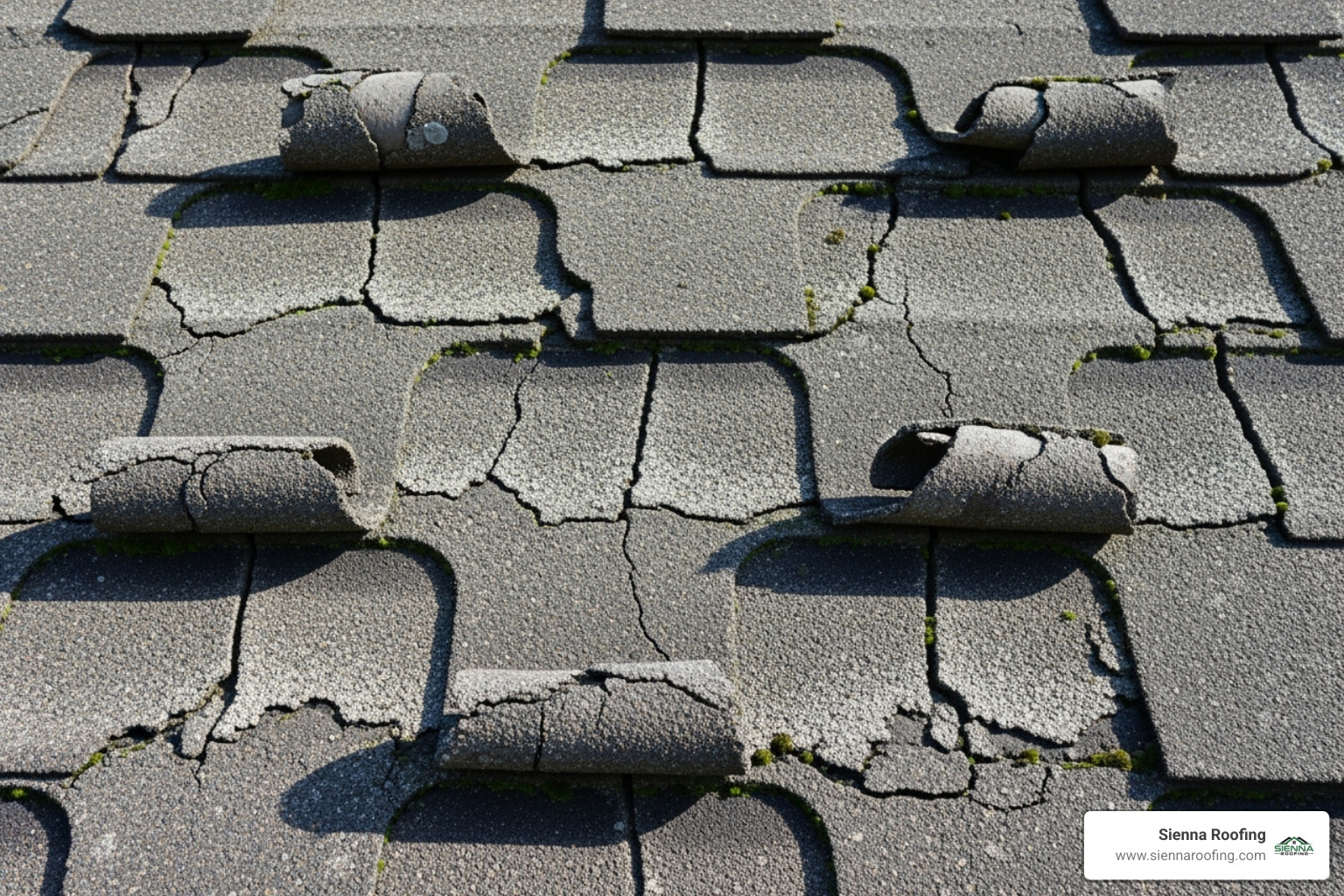
One of the biggest questions homeowners ask about asphalt shingle roofing is, “How long will it last?” The answer depends on a few key factors: the quality of the materials, the local climate, the quality of the installation, and how well the roof is maintained.
Lifespan of Different Asphalt Shingle Roofing Types
The type of shingle you choose directly impacts your roof’s longevity.
- 3-Tab Shingles: The most economical choice, typically lasting 15-20 years. Their single-layer design is best suited for homeowners on a tight budget or those not planning to stay in the home long-term.
- Architectural Shingles: The most popular option, offering a great balance of value and durability with a lifespan of 22-25 years. Their dual-layer construction provides better resistance to wind and storm damage.
- Luxury Shingles: The premium choice, built to last 30 years or more. These thick, heavy shingles offer the best performance and are often backed by lifetime warranties.
Factors like our intense Texas heat, attic ventilation, and installation quality can significantly influence these lifespans. Proper attic airflow is critical, as trapped heat can bake shingles from below and cut their life short. This is why professional installation and regular maintenance are essential for maximizing your roof’s performance.
Common Signs Your Roof Needs Replacement
Knowing when your asphalt shingle roofing is nearing the end of its life can help you avoid costly water damage. Look for these warning signs:
- Curling or Cracking Shingles: Shingles that are cupping or cracking are brittle and have lost their protective qualities.
- Bald Spots and Granule Loss: If you see dark patches on your roof or find a lot of shingle granules in your gutters, the shingles are losing their UV protection.
- Frequent Roof Leaks: While a single leak can be a small issue, multiple or persistent leaks often signal systemic failure.
- Moss or Algae Growth: Heavy moss can trap moisture against the roof, leading to deterioration over time.
- Age of the Roof: If your roof is approaching the end of its expected lifespan (e.g., over 20 years for 3-tab), it’s time to start planning for a replacement.
- Sagging Roof Deck: A sagging roof is a sign of structural issues and requires immediate professional attention.
The Complete System: Installation, Components, and Warranties
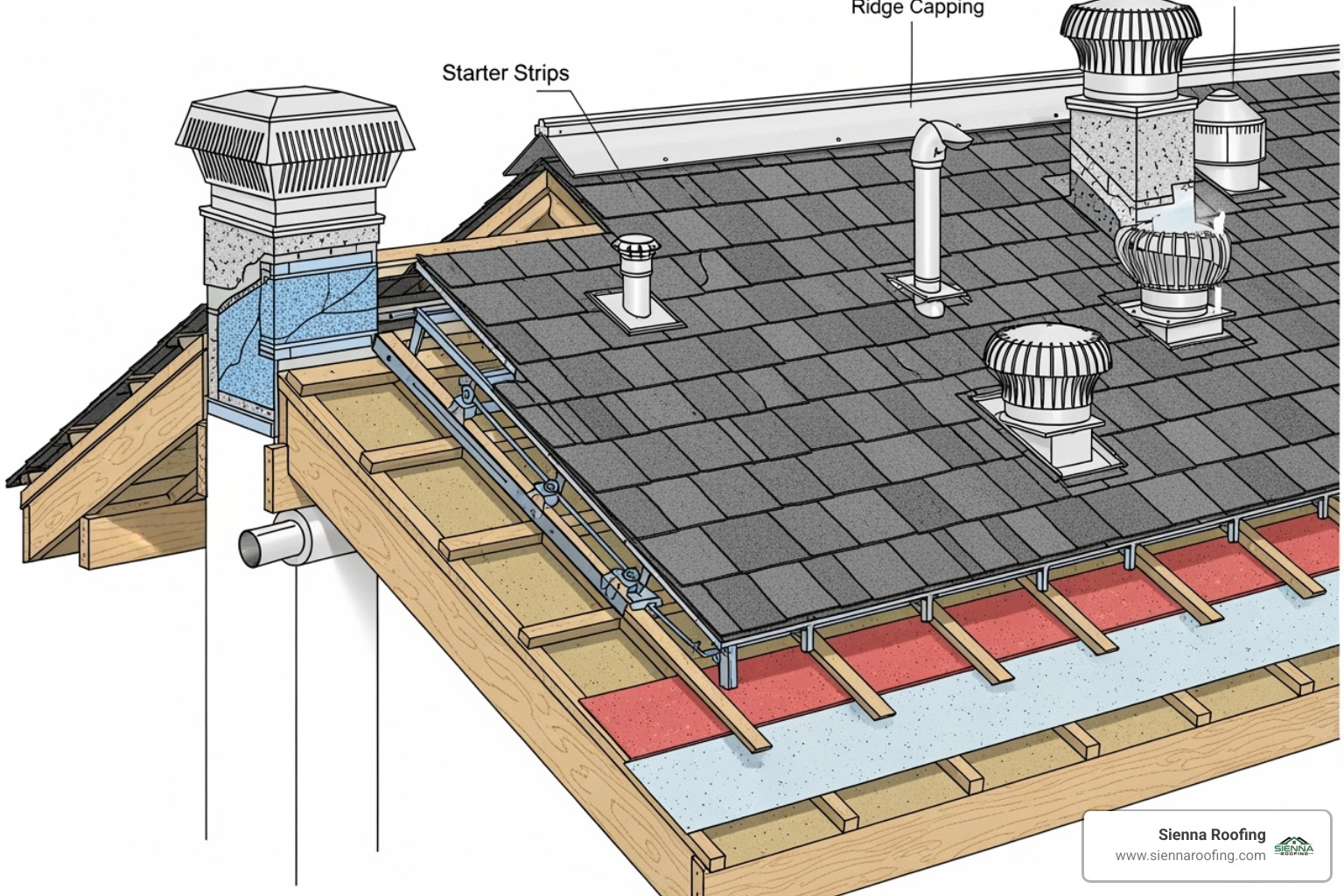
An asphalt shingle roofing installation is more than just the shingles you see. It’s a complete system where every component plays a crucial role in protecting your home. Key components include:
- Roof Decking: The wood foundation (plywood or OSB) that supports the entire system.
- Underlayment: A layer of water-resistant material (felt or synthetic) that provides a secondary barrier against moisture.
- Ice and Water Shield: A self-adhering membrane applied to vulnerable areas like valleys and eaves for extra protection against wind-driven rain.
- Starter Strips: The first course of shingles installed at the eaves to provide a strong seal against wind uplift.
- Flashing: Metal pieces installed around chimneys, vents, and skylights to prevent leaks at penetrations.
- Ridge Capping & Ventilation: Shingles that cover the peak of the roof and vents that allow air to circulate, preventing heat and moisture buildup.
Key Considerations for Your Asphalt Shingle Roofing Installation
Even the best shingles will fail if not installed correctly. Proper installation requires following manufacturer specifications precisely, from nail placement to shingle overlap. This attention to detail is what separates a quality job from a future problem.
Attic ventilation is especially critical in the Texas heat. A well-ventilated attic allows hot, moist air to escape, preventing it from baking your shingles from underneath and drastically shortening their lifespan. Proper airflow helps your entire roofing system perform as designed and can even lower your energy bills.
Understanding Your Roofing Warranties
When you get a new roof, you typically receive two warranties:
- Manufacturer Warranty: This covers defects in the roofing materials themselves. Coverage varies from 15 years to “lifetime” (often for the original owner) and may be prorated over time.
- Workmanship Warranty: This comes from your contractor and covers errors made during installation. Since most roof failures are due to installation issues, a strong workmanship warranty is vital. A reputable contractor will stand behind their work, offering you peace of mind.
Be sure to ask about warranty length and whether it’s transferable if you sell your home. Storm damage is typically covered by homeowner’s insurance, not warranties.
Frequently Asked Questions about Asphalt Shingle Roofing
We get many great questions about asphalt shingle roofing from homeowners across the Houston area. Here are answers to some of the most common ones.
How do I know if my roof has hail or storm damage?
After a storm, check for signs of damage. Look for dents or dark, circular bruises on shingles where granules have been knocked off. An excessive amount of these granules in your gutters is another key indicator. High winds can cause cracked, bent, or missing shingles. Also, check for dents on gutters, downspouts, and A/C units, as this often signals that the roof was also hit. The best course of action after a major storm is to get a professional inspection to assess the damage accurately. For more details, you can read our guide on hail damage to asphalt shingles.
Can you install new asphalt shingles over an old roof?
This is called a “re-roof” or “overlay,” and while it can save on labor costs, it’s often not the best solution. Most building codes limit roofs to two layers, so a tear-off is required if you already have two. An overlay is only possible if the existing roof is in very good condition, with no rot or sagging. However, this method can trap heat, shorten the new shingles’ life, add significant weight to your home’s structure, and hide underlying deck problems. For these reasons, a full tear-off is almost always recommended for a longer-lasting, higher-performing roof.
What is the environmental impact of asphalt shingles?
As a petroleum-based product, asphalt shingle roofing does have an environmental footprint, primarily related to production and landfill waste. The U.S. generates about 11 million tons of shingle waste annually. The good news is that the industry is improving its sustainability. Shingle recycling is becoming more common, where old shingles are ground up and reused in asphalt paving mixes for roads. This diverts waste from landfills and reduces the need for new asphalt. Additionally, the use of cool roof shingles helps reduce energy consumption, making asphalt a more environmentally responsible choice than it once was.
Your Trusted Partner for Asphalt Shingle Roofing
Throughout this guide, we’ve seen why asphalt shingle roofing is the top choice for nearly 70% of American homeowners. It delivers an outstanding mix of affordability, aesthetic versatility, and reliable protection.
Whether you choose economical 3-tab, balanced dimensional, or premium luxury shingles, you’re investing in a proven roofing system. With hundreds of colors and styles available, your roof can be both beautiful and durable. However, the quality of the shingles is only half the equation. Choosing the right shingle type and contractor is absolutely key to a long-lasting, worry-free roof. Expert installation and attention to the complete roofing system are what ensure decades of performance.
For homeowners in Sugar Land, Missouri City, Katy, and the greater Houston area, Sienna Roofing offers more than just a new roof—we offer peace of mind. We provide personalized consultations custom to your home, budget, and style, all backed by our 100% satisfaction guarantee.
We are your neighbors, committed to helping you make the best decision for your family. Ready to see how asphalt shingle roofing can improve your home’s protection and appearance? Explore our asphalt shingle roofing services to learn more about your options.
Let’s work together to give your home the quality roof it deserves. Your home is your biggest investment, and we’re here to protect it with the care and expertise it deserves.
